Financial Market and Monitory Policy
VerifiedAdded on 2021/06/18
|16
|3531
|128
AI Summary
Contribute Materials
Your contribution can guide someone’s learning journey. Share your
documents today.
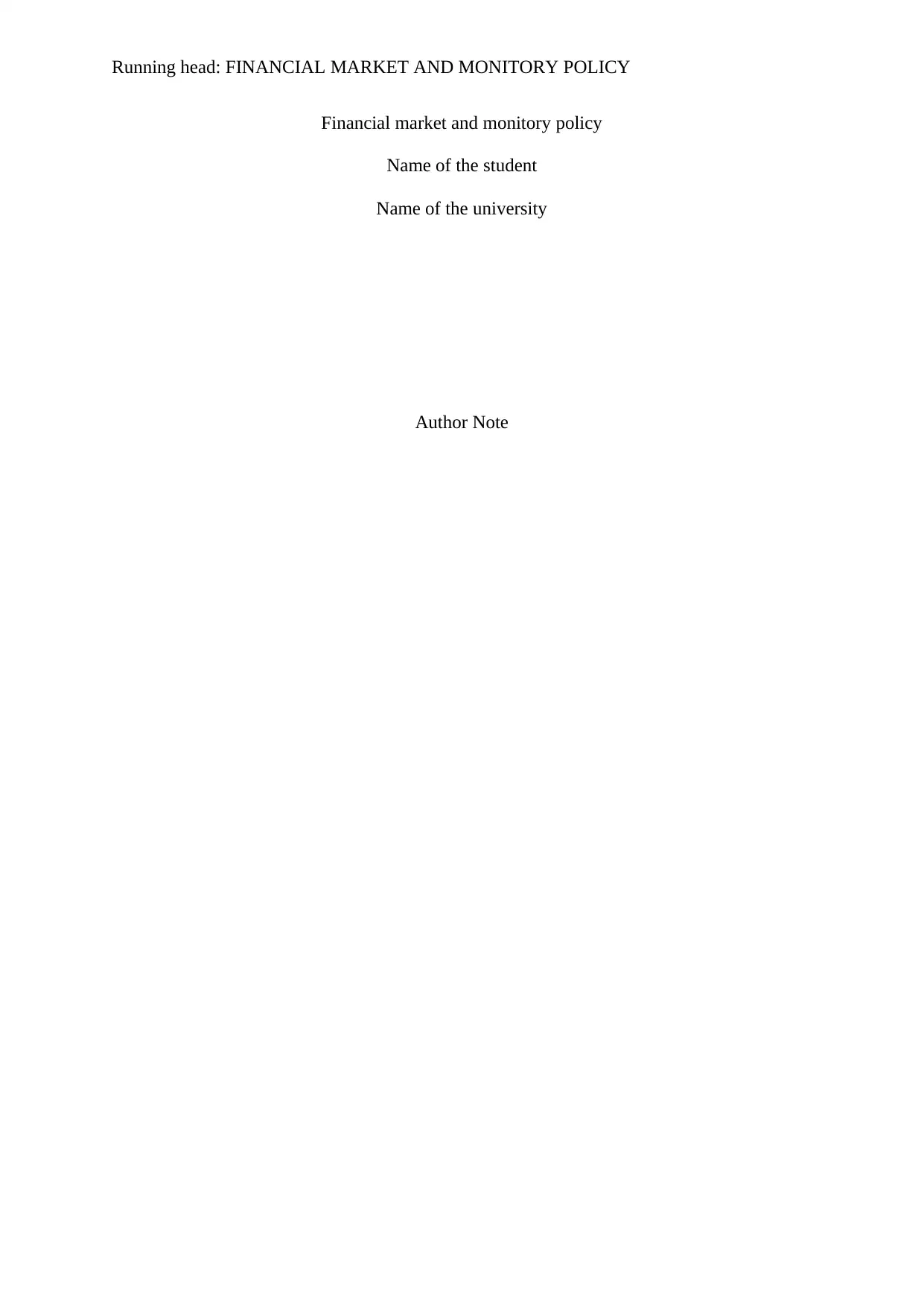
Running head: FINANCIAL MARKET AND MONITORY POLICY
Financial market and monitory policy
Name of the student
Name of the university
Author Note
Financial market and monitory policy
Name of the student
Name of the university
Author Note
Secure Best Marks with AI Grader
Need help grading? Try our AI Grader for instant feedback on your assignments.
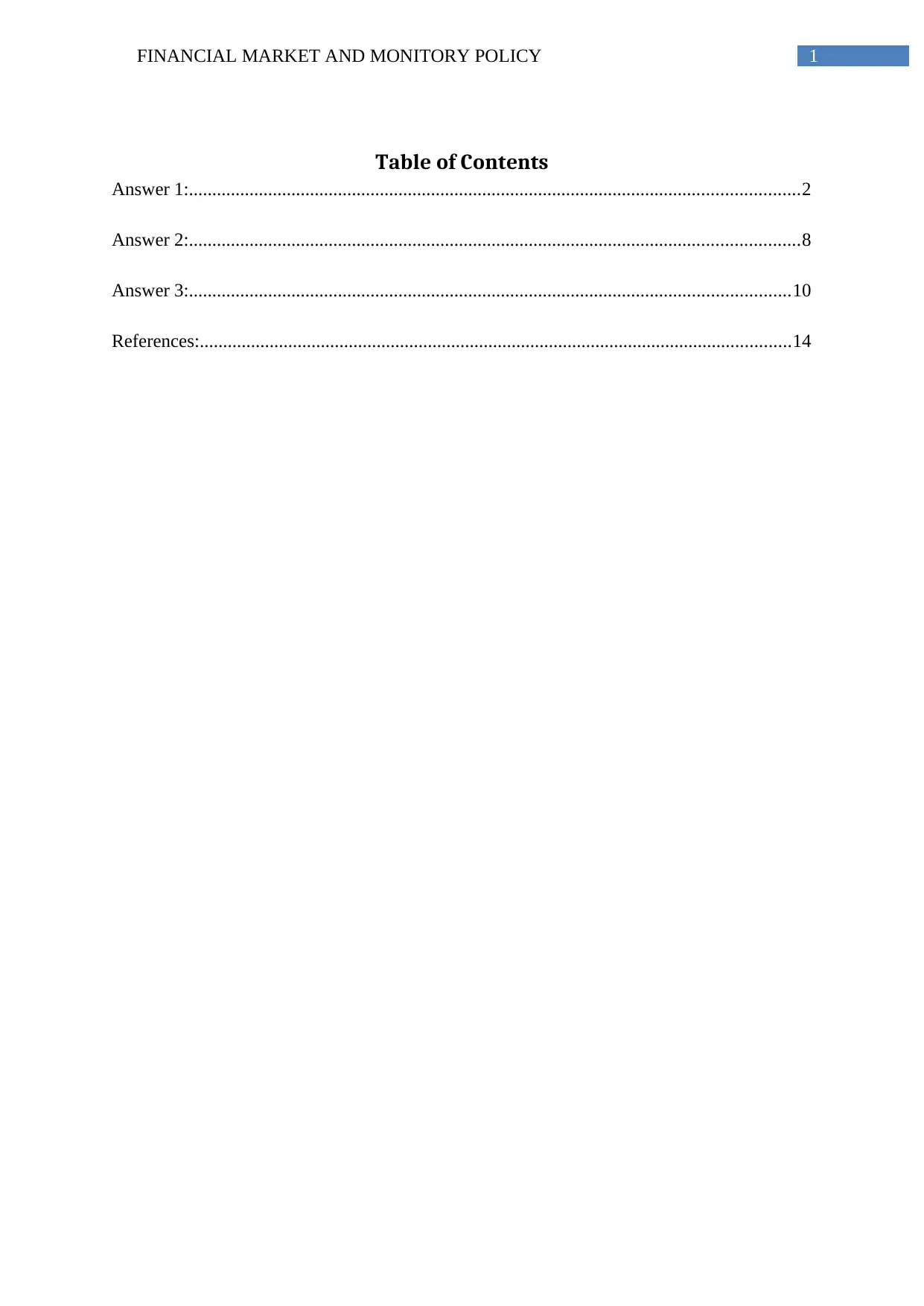
1FINANCIAL MARKET AND MONITORY POLICY
Table of Contents
Answer 1:...................................................................................................................................2
Answer 2:...................................................................................................................................8
Answer 3:.................................................................................................................................10
References:...............................................................................................................................14
Table of Contents
Answer 1:...................................................................................................................................2
Answer 2:...................................................................................................................................8
Answer 3:.................................................................................................................................10
References:...............................................................................................................................14
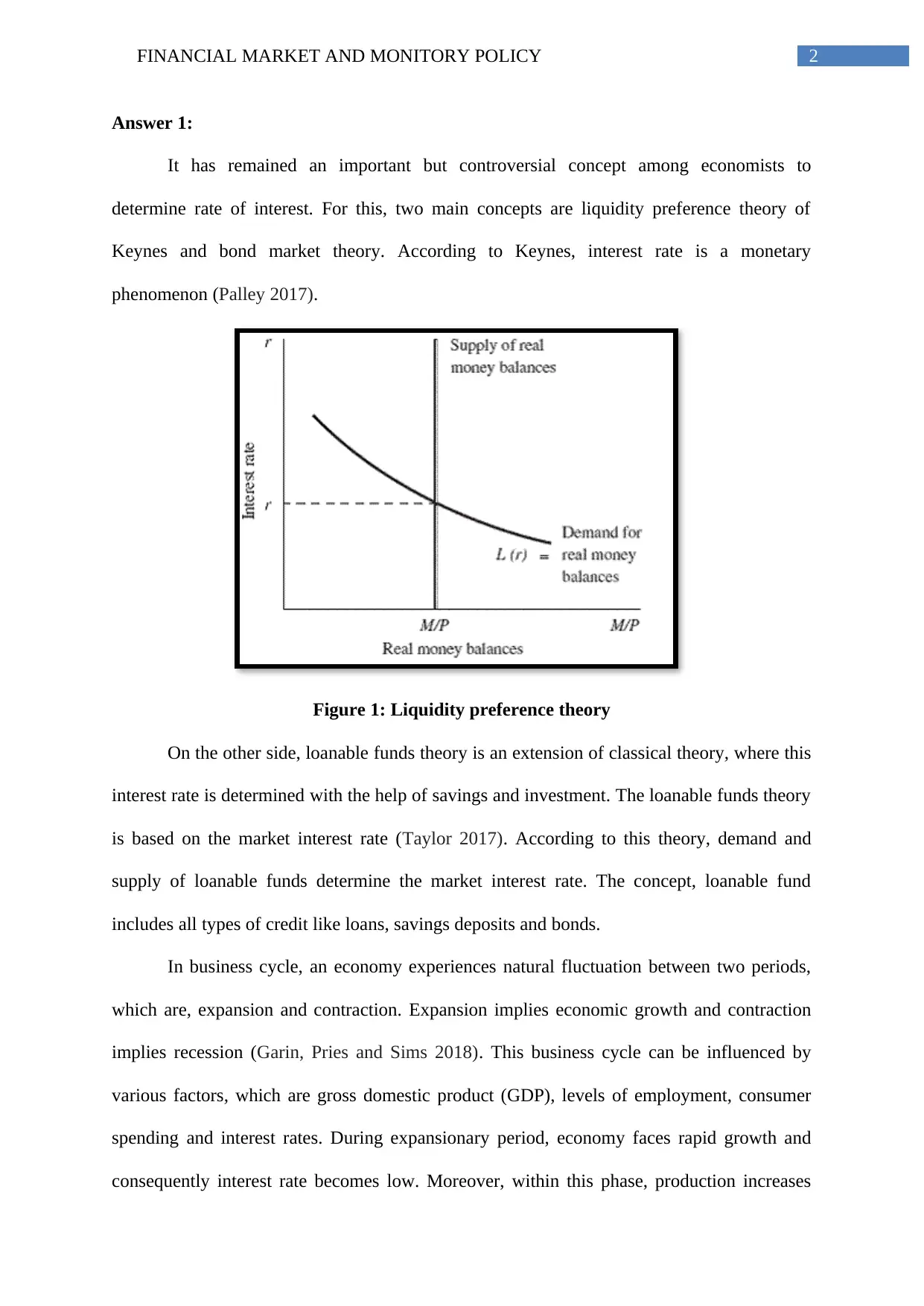
2FINANCIAL MARKET AND MONITORY POLICY
Answer 1:
It has remained an important but controversial concept among economists to
determine rate of interest. For this, two main concepts are liquidity preference theory of
Keynes and bond market theory. According to Keynes, interest rate is a monetary
phenomenon (Palley 2017).
Figure 1: Liquidity preference theory
On the other side, loanable funds theory is an extension of classical theory, where this
interest rate is determined with the help of savings and investment. The loanable funds theory
is based on the market interest rate (Taylor 2017). According to this theory, demand and
supply of loanable funds determine the market interest rate. The concept, loanable fund
includes all types of credit like loans, savings deposits and bonds.
In business cycle, an economy experiences natural fluctuation between two periods,
which are, expansion and contraction. Expansion implies economic growth and contraction
implies recession (Garin, Pries and Sims 2018). This business cycle can be influenced by
various factors, which are gross domestic product (GDP), levels of employment, consumer
spending and interest rates. During expansionary period, economy faces rapid growth and
consequently interest rate becomes low. Moreover, within this phase, production increases
Answer 1:
It has remained an important but controversial concept among economists to
determine rate of interest. For this, two main concepts are liquidity preference theory of
Keynes and bond market theory. According to Keynes, interest rate is a monetary
phenomenon (Palley 2017).
Figure 1: Liquidity preference theory
On the other side, loanable funds theory is an extension of classical theory, where this
interest rate is determined with the help of savings and investment. The loanable funds theory
is based on the market interest rate (Taylor 2017). According to this theory, demand and
supply of loanable funds determine the market interest rate. The concept, loanable fund
includes all types of credit like loans, savings deposits and bonds.
In business cycle, an economy experiences natural fluctuation between two periods,
which are, expansion and contraction. Expansion implies economic growth and contraction
implies recession (Garin, Pries and Sims 2018). This business cycle can be influenced by
various factors, which are gross domestic product (GDP), levels of employment, consumer
spending and interest rates. During expansionary period, economy faces rapid growth and
consequently interest rate becomes low. Moreover, within this phase, production increases
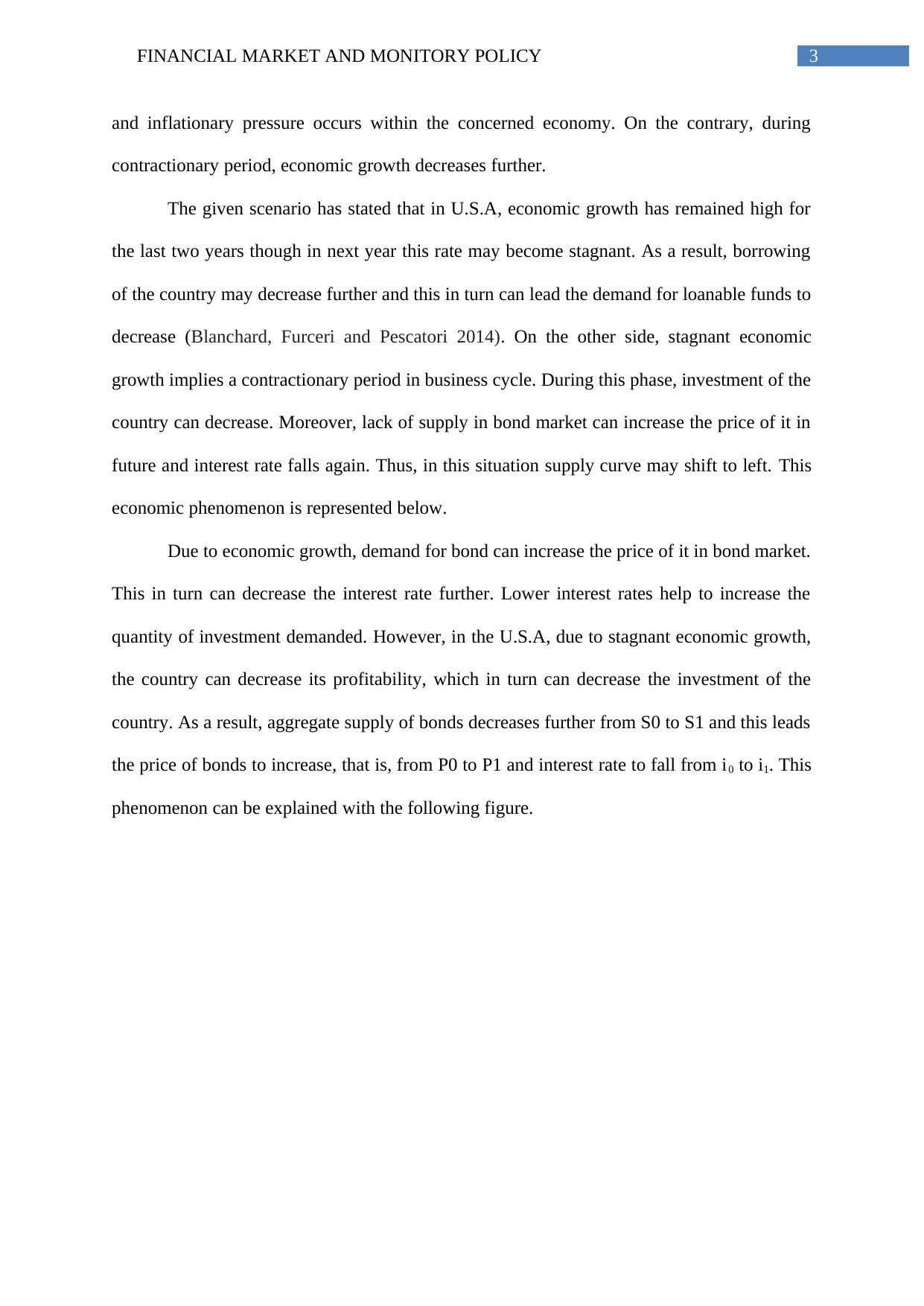
3FINANCIAL MARKET AND MONITORY POLICY
and inflationary pressure occurs within the concerned economy. On the contrary, during
contractionary period, economic growth decreases further.
The given scenario has stated that in U.S.A, economic growth has remained high for
the last two years though in next year this rate may become stagnant. As a result, borrowing
of the country may decrease further and this in turn can lead the demand for loanable funds to
decrease (Blanchard, Furceri and Pescatori 2014). On the other side, stagnant economic
growth implies a contractionary period in business cycle. During this phase, investment of the
country can decrease. Moreover, lack of supply in bond market can increase the price of it in
future and interest rate falls again. Thus, in this situation supply curve may shift to left. This
economic phenomenon is represented below.
Due to economic growth, demand for bond can increase the price of it in bond market.
This in turn can decrease the interest rate further. Lower interest rates help to increase the
quantity of investment demanded. However, in the U.S.A, due to stagnant economic growth,
the country can decrease its profitability, which in turn can decrease the investment of the
country. As a result, aggregate supply of bonds decreases further from S0 to S1 and this leads
the price of bonds to increase, that is, from P0 to P1 and interest rate to fall from i0 to i1. This
phenomenon can be explained with the following figure.
and inflationary pressure occurs within the concerned economy. On the contrary, during
contractionary period, economic growth decreases further.
The given scenario has stated that in U.S.A, economic growth has remained high for
the last two years though in next year this rate may become stagnant. As a result, borrowing
of the country may decrease further and this in turn can lead the demand for loanable funds to
decrease (Blanchard, Furceri and Pescatori 2014). On the other side, stagnant economic
growth implies a contractionary period in business cycle. During this phase, investment of the
country can decrease. Moreover, lack of supply in bond market can increase the price of it in
future and interest rate falls again. Thus, in this situation supply curve may shift to left. This
economic phenomenon is represented below.
Due to economic growth, demand for bond can increase the price of it in bond market.
This in turn can decrease the interest rate further. Lower interest rates help to increase the
quantity of investment demanded. However, in the U.S.A, due to stagnant economic growth,
the country can decrease its profitability, which in turn can decrease the investment of the
country. As a result, aggregate supply of bonds decreases further from S0 to S1 and this leads
the price of bonds to increase, that is, from P0 to P1 and interest rate to fall from i0 to i1. This
phenomenon can be explained with the following figure.
Secure Best Marks with AI Grader
Need help grading? Try our AI Grader for instant feedback on your assignments.

4FINANCIAL MARKET AND MONITORY POLICY
Price of bonds
Quantity of bonds
Interest rate (i)
Quantity of loanable
funds
S1
S0
DB
D0
D1
SL
P0
P1
i0
i1
Figure 2: Economic growth and impact in bond market
According to Keynesian theory of Liquidity preference, due to stagnant economic
growth, real GDP of the U.S.A can decrease and this in turn can reduce the number of real
transaction. Thus, people may not prefer to hold more cash as liquid for transaction purpose.
Hence, demand for cash decreases and this further can lead the interest rate to decrease.
Price of bonds
Quantity of bonds
Interest rate (i)
Quantity of loanable
funds
S1
S0
DB
D0
D1
SL
P0
P1
i0
i1
Figure 2: Economic growth and impact in bond market
According to Keynesian theory of Liquidity preference, due to stagnant economic
growth, real GDP of the U.S.A can decrease and this in turn can reduce the number of real
transaction. Thus, people may not prefer to hold more cash as liquid for transaction purpose.
Hence, demand for cash decreases and this further can lead the interest rate to decrease.
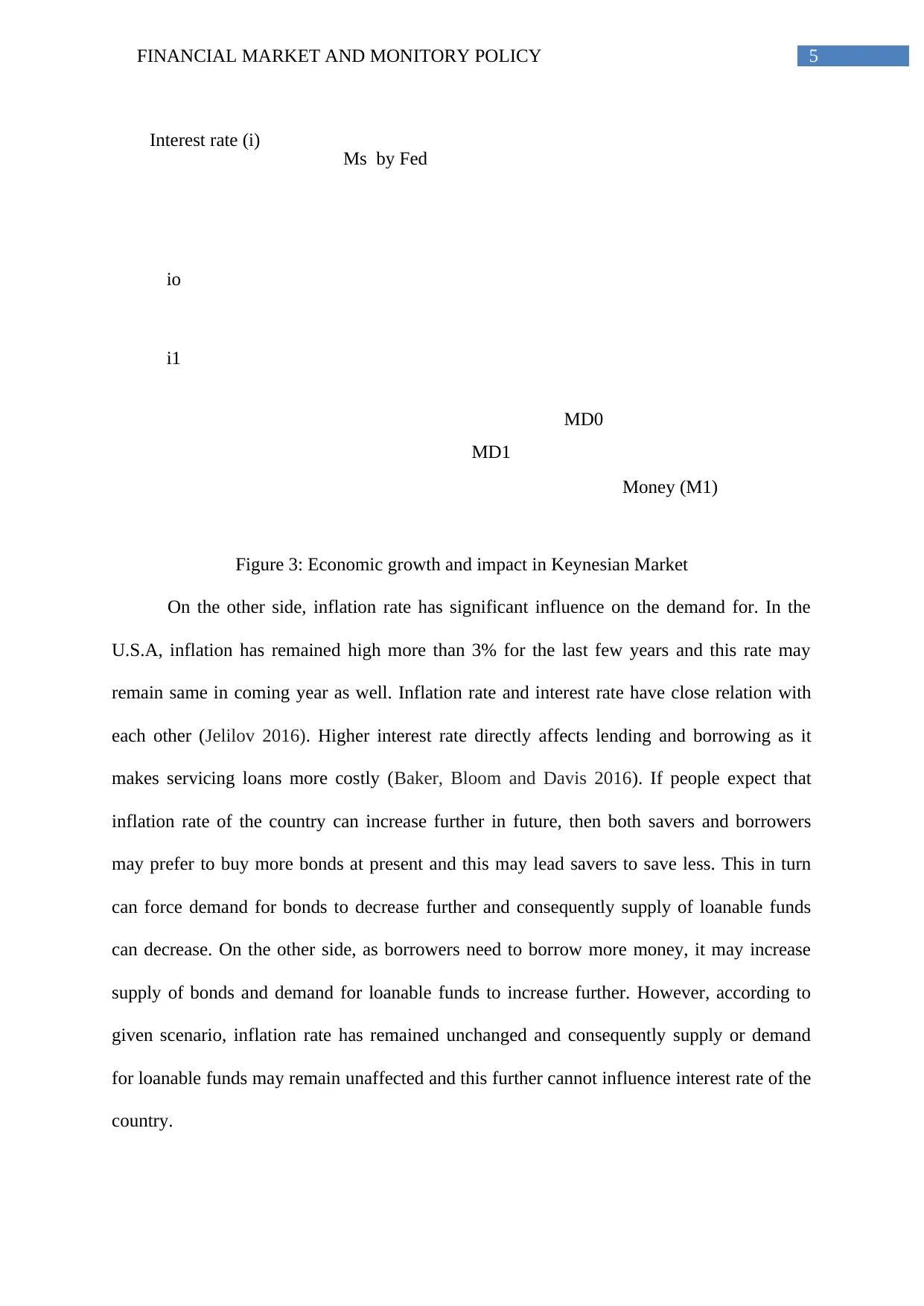
5FINANCIAL MARKET AND MONITORY POLICY
MD0
MD1
Ms by Fed
Interest rate (i)
Money (M1)
io
i1
Figure 3: Economic growth and impact in Keynesian Market
On the other side, inflation rate has significant influence on the demand for. In the
U.S.A, inflation has remained high more than 3% for the last few years and this rate may
remain same in coming year as well. Inflation rate and interest rate have close relation with
each other (Jelilov 2016). Higher interest rate directly affects lending and borrowing as it
makes servicing loans more costly (Baker, Bloom and Davis 2016). If people expect that
inflation rate of the country can increase further in future, then both savers and borrowers
may prefer to buy more bonds at present and this may lead savers to save less. This in turn
can force demand for bonds to decrease further and consequently supply of loanable funds
can decrease. On the other side, as borrowers need to borrow more money, it may increase
supply of bonds and demand for loanable funds to increase further. However, according to
given scenario, inflation rate has remained unchanged and consequently supply or demand
for loanable funds may remain unaffected and this further cannot influence interest rate of the
country.
MD0
MD1
Ms by Fed
Interest rate (i)
Money (M1)
io
i1
Figure 3: Economic growth and impact in Keynesian Market
On the other side, inflation rate has significant influence on the demand for. In the
U.S.A, inflation has remained high more than 3% for the last few years and this rate may
remain same in coming year as well. Inflation rate and interest rate have close relation with
each other (Jelilov 2016). Higher interest rate directly affects lending and borrowing as it
makes servicing loans more costly (Baker, Bloom and Davis 2016). If people expect that
inflation rate of the country can increase further in future, then both savers and borrowers
may prefer to buy more bonds at present and this may lead savers to save less. This in turn
can force demand for bonds to decrease further and consequently supply of loanable funds
can decrease. On the other side, as borrowers need to borrow more money, it may increase
supply of bonds and demand for loanable funds to increase further. However, according to
given scenario, inflation rate has remained unchanged and consequently supply or demand
for loanable funds may remain unaffected and this further cannot influence interest rate of the
country.

6FINANCIAL MARKET AND MONITORY POLICY
P0
P1
Price of bonds
Quantity of bonds
Interest rate (i)
Quantity of loanable funds
i0
i1
S0
S1
DB D0
SL
D1
On the other side, in Keynesian model, due to unchanged rate of inflation, consumers
and business organizations may remain unaffected regarding holding of money. Hence, at this
situation, demand for money can remain unchanged and this consequently cannot affect
interest rate anymore.
The Federal government, on the other side, is going to cut its spending to decrease
budget deficit. This implies that at present scenario, government expenditure is high compare
to its tax revenue. However, in future, the government can earn budget surplus and as a result,
it can repurchase its bonds from market. This further can reduce the supply of bonds and
consequently, price of it can increase further. Hence, increasing price can lead the interest
rate in market by lowering demand for bonds (Kelikume 2016). Thus, supply curve of
loanable funds in this situation can shift to the left.
Figure 4: Reduce in government expenditure and impact in bond market
P0
P1
Price of bonds
Quantity of bonds
Interest rate (i)
Quantity of loanable funds
i0
i1
S0
S1
DB D0
SL
D1
On the other side, in Keynesian model, due to unchanged rate of inflation, consumers
and business organizations may remain unaffected regarding holding of money. Hence, at this
situation, demand for money can remain unchanged and this consequently cannot affect
interest rate anymore.
The Federal government, on the other side, is going to cut its spending to decrease
budget deficit. This implies that at present scenario, government expenditure is high compare
to its tax revenue. However, in future, the government can earn budget surplus and as a result,
it can repurchase its bonds from market. This further can reduce the supply of bonds and
consequently, price of it can increase further. Hence, increasing price can lead the interest
rate in market by lowering demand for bonds (Kelikume 2016). Thus, supply curve of
loanable funds in this situation can shift to the left.
Figure 4: Reduce in government expenditure and impact in bond market
Paraphrase This Document
Need a fresh take? Get an instant paraphrase of this document with our AI Paraphraser
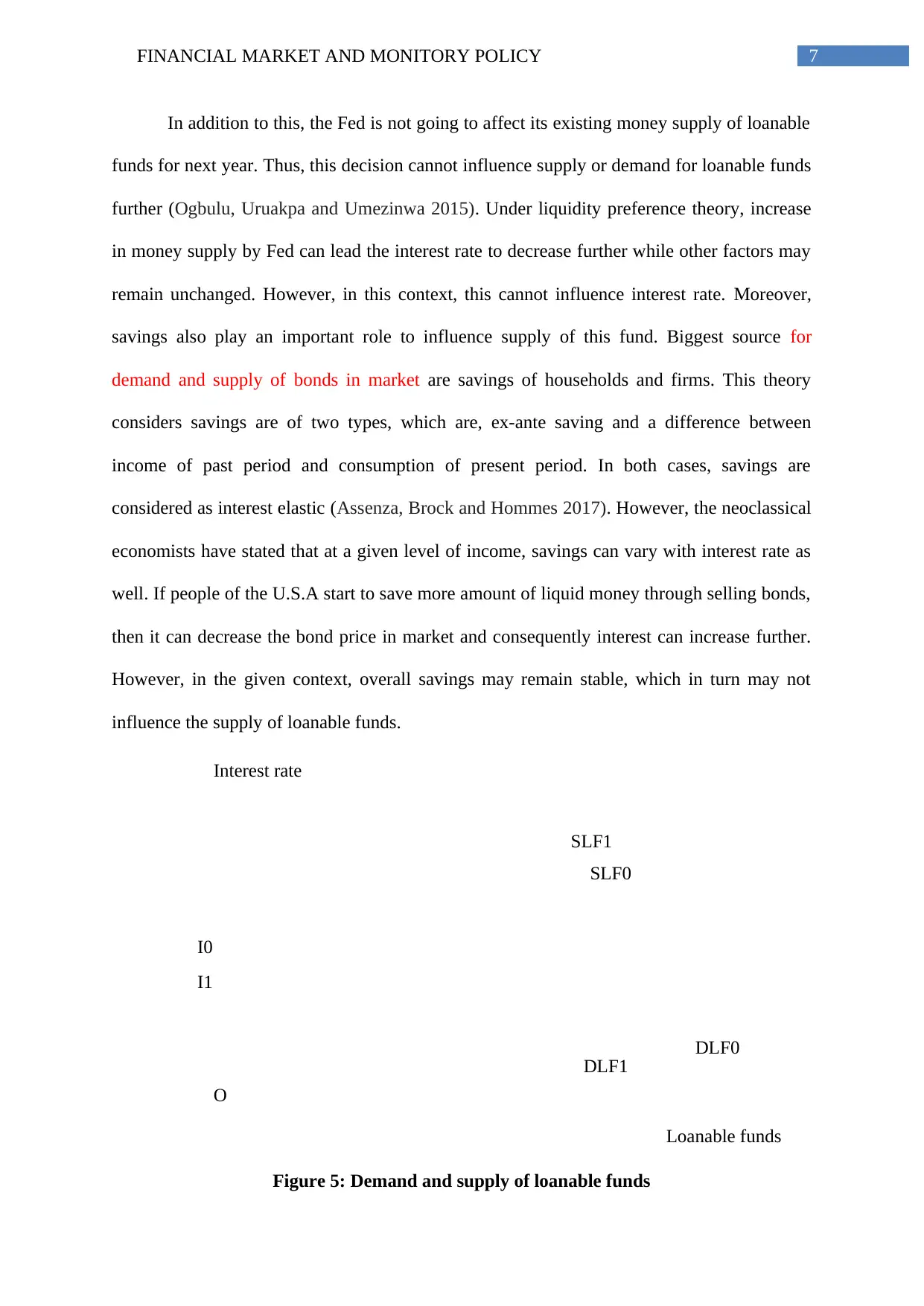
7FINANCIAL MARKET AND MONITORY POLICY
Interest rate
Loanable funds
O
DLF0
SLF0
DLF1
I0
I1
SLF1
In addition to this, the Fed is not going to affect its existing money supply of loanable
funds for next year. Thus, this decision cannot influence supply or demand for loanable funds
further (Ogbulu, Uruakpa and Umezinwa 2015). Under liquidity preference theory, increase
in money supply by Fed can lead the interest rate to decrease further while other factors may
remain unchanged. However, in this context, this cannot influence interest rate. Moreover,
savings also play an important role to influence supply of this fund. Biggest source for
demand and supply of bonds in market are savings of households and firms. This theory
considers savings are of two types, which are, ex-ante saving and a difference between
income of past period and consumption of present period. In both cases, savings are
considered as interest elastic (Assenza, Brock and Hommes 2017). However, the neoclassical
economists have stated that at a given level of income, savings can vary with interest rate as
well. If people of the U.S.A start to save more amount of liquid money through selling bonds,
then it can decrease the bond price in market and consequently interest can increase further.
However, in the given context, overall savings may remain stable, which in turn may not
influence the supply of loanable funds.
Figure 5: Demand and supply of loanable funds
Interest rate
Loanable funds
O
DLF0
SLF0
DLF1
I0
I1
SLF1
In addition to this, the Fed is not going to affect its existing money supply of loanable
funds for next year. Thus, this decision cannot influence supply or demand for loanable funds
further (Ogbulu, Uruakpa and Umezinwa 2015). Under liquidity preference theory, increase
in money supply by Fed can lead the interest rate to decrease further while other factors may
remain unchanged. However, in this context, this cannot influence interest rate. Moreover,
savings also play an important role to influence supply of this fund. Biggest source for
demand and supply of bonds in market are savings of households and firms. This theory
considers savings are of two types, which are, ex-ante saving and a difference between
income of past period and consumption of present period. In both cases, savings are
considered as interest elastic (Assenza, Brock and Hommes 2017). However, the neoclassical
economists have stated that at a given level of income, savings can vary with interest rate as
well. If people of the U.S.A start to save more amount of liquid money through selling bonds,
then it can decrease the bond price in market and consequently interest can increase further.
However, in the given context, overall savings may remain stable, which in turn may not
influence the supply of loanable funds.
Figure 5: Demand and supply of loanable funds
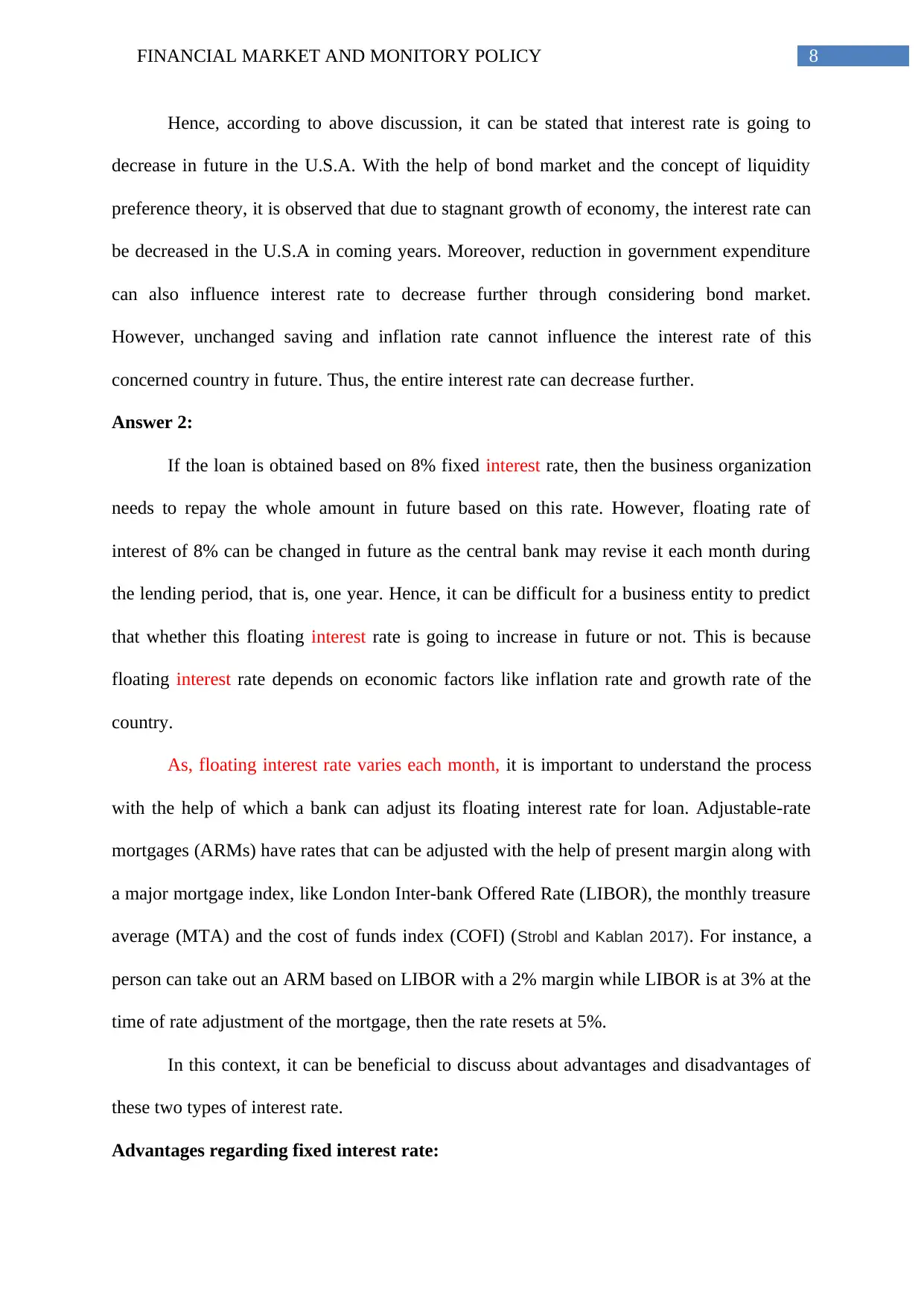
8FINANCIAL MARKET AND MONITORY POLICY
Hence, according to above discussion, it can be stated that interest rate is going to
decrease in future in the U.S.A. With the help of bond market and the concept of liquidity
preference theory, it is observed that due to stagnant growth of economy, the interest rate can
be decreased in the U.S.A in coming years. Moreover, reduction in government expenditure
can also influence interest rate to decrease further through considering bond market.
However, unchanged saving and inflation rate cannot influence the interest rate of this
concerned country in future. Thus, the entire interest rate can decrease further.
Answer 2:
If the loan is obtained based on 8% fixed interest rate, then the business organization
needs to repay the whole amount in future based on this rate. However, floating rate of
interest of 8% can be changed in future as the central bank may revise it each month during
the lending period, that is, one year. Hence, it can be difficult for a business entity to predict
that whether this floating interest rate is going to increase in future or not. This is because
floating interest rate depends on economic factors like inflation rate and growth rate of the
country.
As, floating interest rate varies each month, it is important to understand the process
with the help of which a bank can adjust its floating interest rate for loan. Adjustable-rate
mortgages (ARMs) have rates that can be adjusted with the help of present margin along with
a major mortgage index, like London Inter-bank Offered Rate (LIBOR), the monthly treasure
average (MTA) and the cost of funds index (COFI) (Strobl and Kablan 2017). For instance, a
person can take out an ARM based on LIBOR with a 2% margin while LIBOR is at 3% at the
time of rate adjustment of the mortgage, then the rate resets at 5%.
In this context, it can be beneficial to discuss about advantages and disadvantages of
these two types of interest rate.
Advantages regarding fixed interest rate:
Hence, according to above discussion, it can be stated that interest rate is going to
decrease in future in the U.S.A. With the help of bond market and the concept of liquidity
preference theory, it is observed that due to stagnant growth of economy, the interest rate can
be decreased in the U.S.A in coming years. Moreover, reduction in government expenditure
can also influence interest rate to decrease further through considering bond market.
However, unchanged saving and inflation rate cannot influence the interest rate of this
concerned country in future. Thus, the entire interest rate can decrease further.
Answer 2:
If the loan is obtained based on 8% fixed interest rate, then the business organization
needs to repay the whole amount in future based on this rate. However, floating rate of
interest of 8% can be changed in future as the central bank may revise it each month during
the lending period, that is, one year. Hence, it can be difficult for a business entity to predict
that whether this floating interest rate is going to increase in future or not. This is because
floating interest rate depends on economic factors like inflation rate and growth rate of the
country.
As, floating interest rate varies each month, it is important to understand the process
with the help of which a bank can adjust its floating interest rate for loan. Adjustable-rate
mortgages (ARMs) have rates that can be adjusted with the help of present margin along with
a major mortgage index, like London Inter-bank Offered Rate (LIBOR), the monthly treasure
average (MTA) and the cost of funds index (COFI) (Strobl and Kablan 2017). For instance, a
person can take out an ARM based on LIBOR with a 2% margin while LIBOR is at 3% at the
time of rate adjustment of the mortgage, then the rate resets at 5%.
In this context, it can be beneficial to discuss about advantages and disadvantages of
these two types of interest rate.
Advantages regarding fixed interest rate:

9FINANCIAL MARKET AND MONITORY POLICY
The chief benefit that can be obtained through choosing fixed interest rate is
predictability. In this situation, interest rate remains unchanged and consequently, payments
of businessperson may remain same. Hence, during short-term, it can be beneficial for the
business organization to take loan under fixed interest rate (Arrow 2017). Moreover, this
fixed interest rate also allows the company to estimate tax benefits that it can get after
deducting the loan interest for every year. However, for floating interest rate, it can be
difficult to measure tax benefit.
However, this fixed interest rate has some disadvantages, as well. For a small business
firm, a fixed interest rate may cause more costs for on a loan compare to the floating interest
rate during long period.
Figure 6: Fixed exchange rate
Advantages and disadvantages of floating interest rate:
This floating interest rate can be lower compare to fixed interest rate and this in turn
can help a business organization to take more loans and to bear less cost at the time of
repayment. Moreover, with the help of market fluctuation, a business entity can earn
advantage at the time of repayment (Yao 2015). However, on the other side, it is very
difficult for the business organization to predict about the fluctuation of this floating interest
The chief benefit that can be obtained through choosing fixed interest rate is
predictability. In this situation, interest rate remains unchanged and consequently, payments
of businessperson may remain same. Hence, during short-term, it can be beneficial for the
business organization to take loan under fixed interest rate (Arrow 2017). Moreover, this
fixed interest rate also allows the company to estimate tax benefits that it can get after
deducting the loan interest for every year. However, for floating interest rate, it can be
difficult to measure tax benefit.
However, this fixed interest rate has some disadvantages, as well. For a small business
firm, a fixed interest rate may cause more costs for on a loan compare to the floating interest
rate during long period.
Figure 6: Fixed exchange rate
Advantages and disadvantages of floating interest rate:
This floating interest rate can be lower compare to fixed interest rate and this in turn
can help a business organization to take more loans and to bear less cost at the time of
repayment. Moreover, with the help of market fluctuation, a business entity can earn
advantage at the time of repayment (Yao 2015). However, on the other side, it is very
difficult for the business organization to predict about the fluctuation of this floating interest
Secure Best Marks with AI Grader
Need help grading? Try our AI Grader for instant feedback on your assignments.
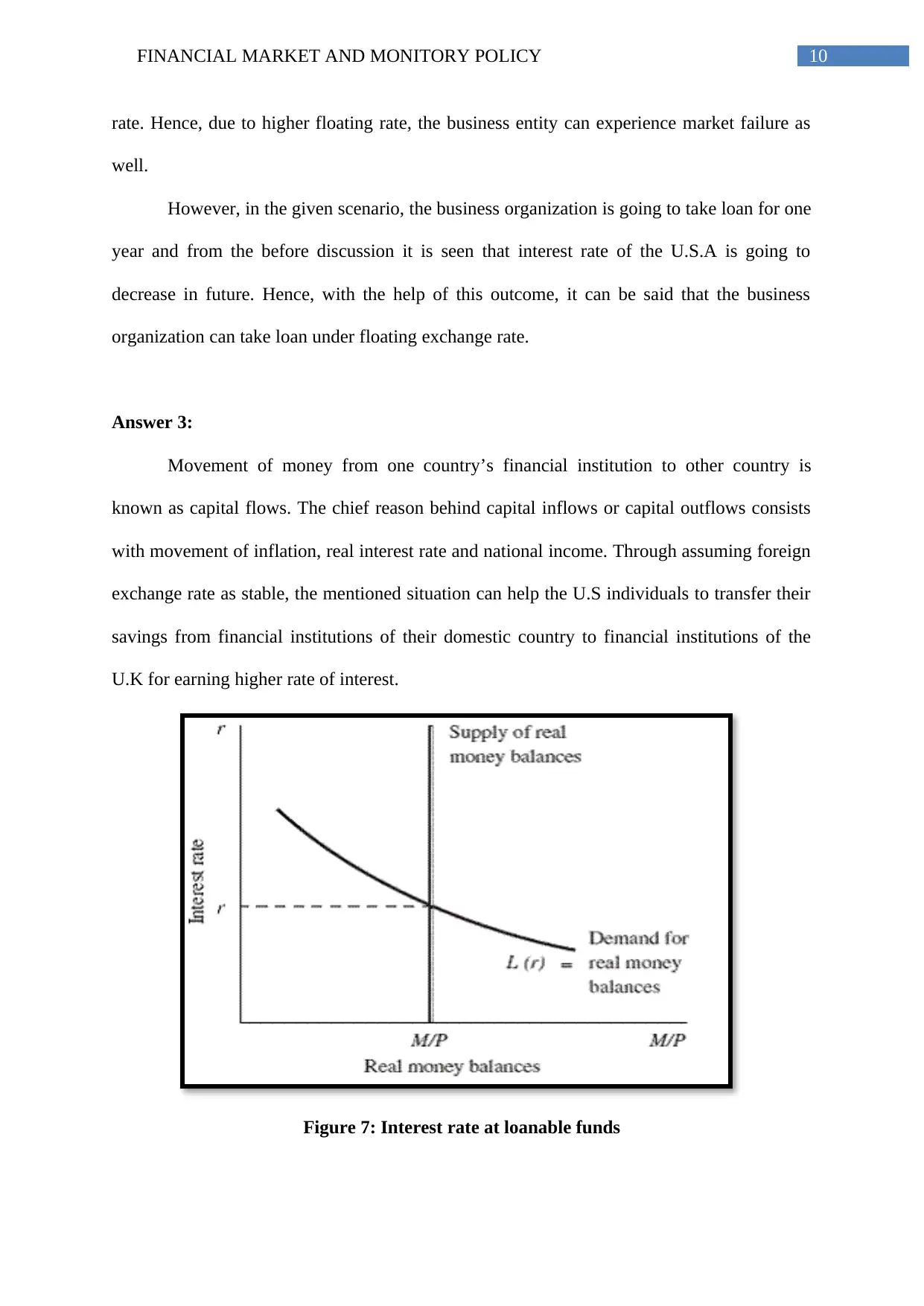
10FINANCIAL MARKET AND MONITORY POLICY
rate. Hence, due to higher floating rate, the business entity can experience market failure as
well.
However, in the given scenario, the business organization is going to take loan for one
year and from the before discussion it is seen that interest rate of the U.S.A is going to
decrease in future. Hence, with the help of this outcome, it can be said that the business
organization can take loan under floating exchange rate.
Answer 3:
Movement of money from one country’s financial institution to other country is
known as capital flows. The chief reason behind capital inflows or capital outflows consists
with movement of inflation, real interest rate and national income. Through assuming foreign
exchange rate as stable, the mentioned situation can help the U.S individuals to transfer their
savings from financial institutions of their domestic country to financial institutions of the
U.K for earning higher rate of interest.
Figure 7: Interest rate at loanable funds
rate. Hence, due to higher floating rate, the business entity can experience market failure as
well.
However, in the given scenario, the business organization is going to take loan for one
year and from the before discussion it is seen that interest rate of the U.S.A is going to
decrease in future. Hence, with the help of this outcome, it can be said that the business
organization can take loan under floating exchange rate.
Answer 3:
Movement of money from one country’s financial institution to other country is
known as capital flows. The chief reason behind capital inflows or capital outflows consists
with movement of inflation, real interest rate and national income. Through assuming foreign
exchange rate as stable, the mentioned situation can help the U.S individuals to transfer their
savings from financial institutions of their domestic country to financial institutions of the
U.K for earning higher rate of interest.
Figure 7: Interest rate at loanable funds
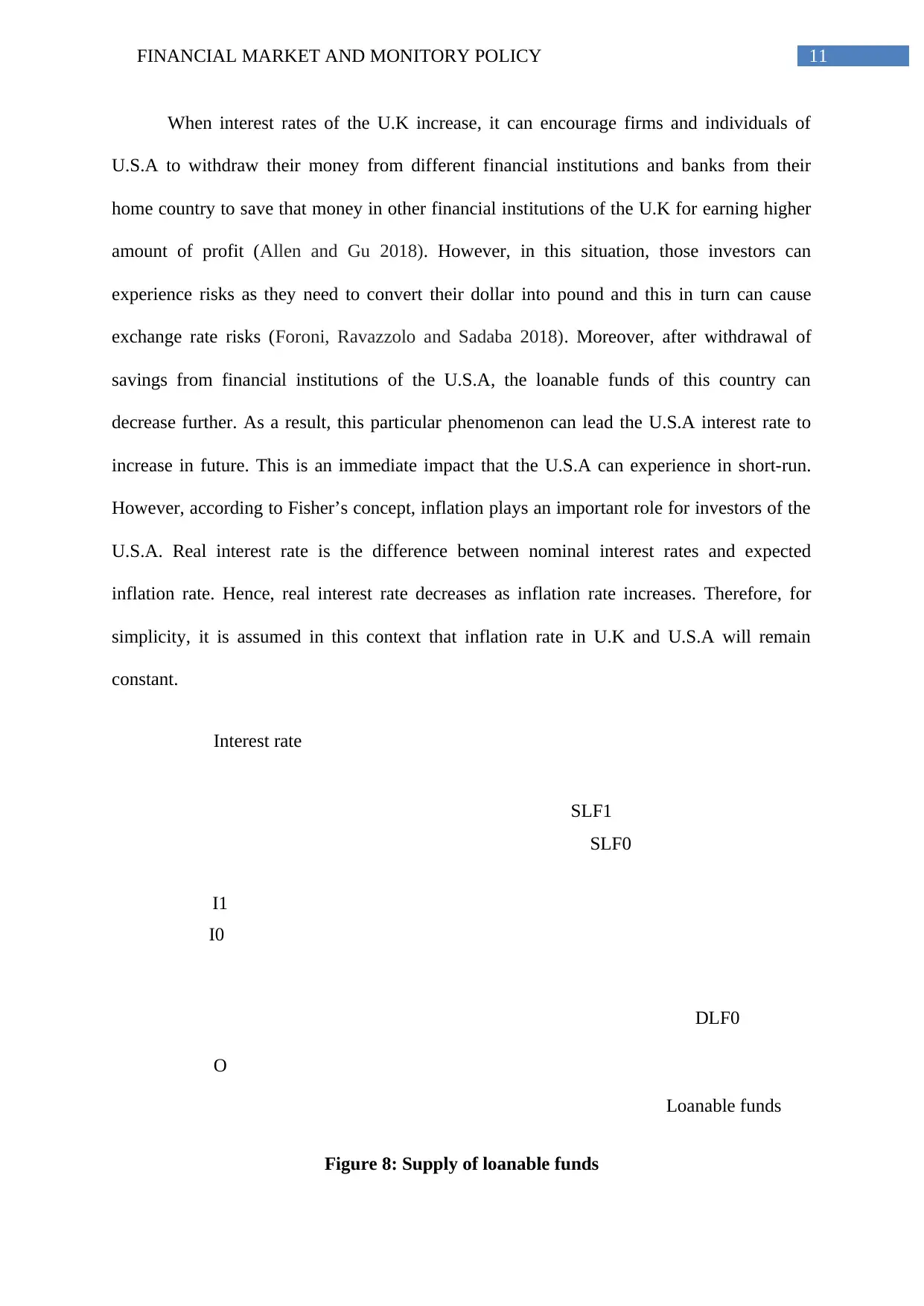
11FINANCIAL MARKET AND MONITORY POLICY
Interest rate
Loanable funds
O
DLF0
SLF0
I0
I1
SLF1
When interest rates of the U.K increase, it can encourage firms and individuals of
U.S.A to withdraw their money from different financial institutions and banks from their
home country to save that money in other financial institutions of the U.K for earning higher
amount of profit (Allen and Gu 2018). However, in this situation, those investors can
experience risks as they need to convert their dollar into pound and this in turn can cause
exchange rate risks (Foroni, Ravazzolo and Sadaba 2018). Moreover, after withdrawal of
savings from financial institutions of the U.S.A, the loanable funds of this country can
decrease further. As a result, this particular phenomenon can lead the U.S.A interest rate to
increase in future. This is an immediate impact that the U.S.A can experience in short-run.
However, according to Fisher’s concept, inflation plays an important role for investors of the
U.S.A. Real interest rate is the difference between nominal interest rates and expected
inflation rate. Hence, real interest rate decreases as inflation rate increases. Therefore, for
simplicity, it is assumed in this context that inflation rate in U.K and U.S.A will remain
constant.
Figure 8: Supply of loanable funds
Interest rate
Loanable funds
O
DLF0
SLF0
I0
I1
SLF1
When interest rates of the U.K increase, it can encourage firms and individuals of
U.S.A to withdraw their money from different financial institutions and banks from their
home country to save that money in other financial institutions of the U.K for earning higher
amount of profit (Allen and Gu 2018). However, in this situation, those investors can
experience risks as they need to convert their dollar into pound and this in turn can cause
exchange rate risks (Foroni, Ravazzolo and Sadaba 2018). Moreover, after withdrawal of
savings from financial institutions of the U.S.A, the loanable funds of this country can
decrease further. As a result, this particular phenomenon can lead the U.S.A interest rate to
increase in future. This is an immediate impact that the U.S.A can experience in short-run.
However, according to Fisher’s concept, inflation plays an important role for investors of the
U.S.A. Real interest rate is the difference between nominal interest rates and expected
inflation rate. Hence, real interest rate decreases as inflation rate increases. Therefore, for
simplicity, it is assumed in this context that inflation rate in U.K and U.S.A will remain
constant.
Figure 8: Supply of loanable funds
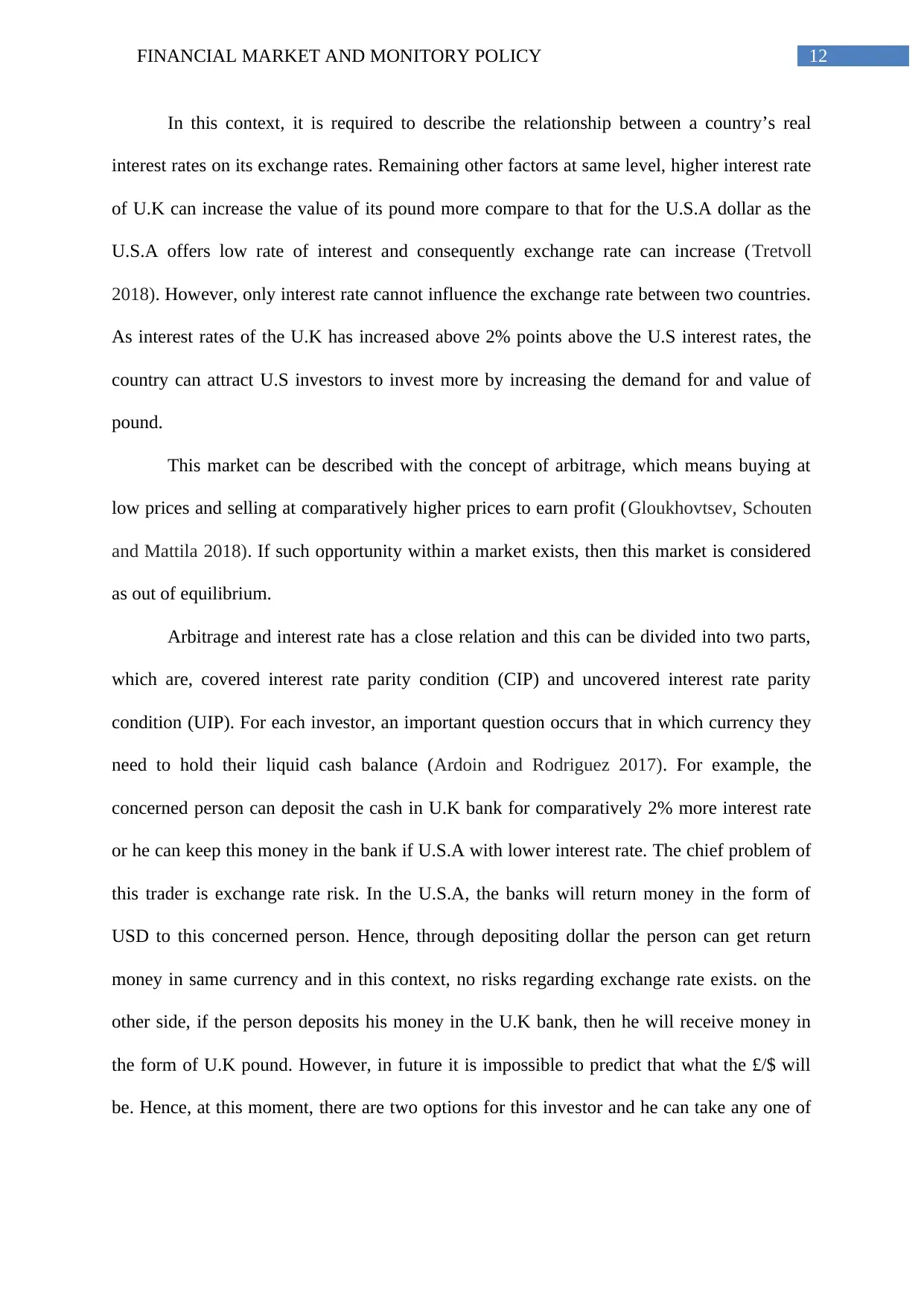
12FINANCIAL MARKET AND MONITORY POLICY
In this context, it is required to describe the relationship between a country’s real
interest rates on its exchange rates. Remaining other factors at same level, higher interest rate
of U.K can increase the value of its pound more compare to that for the U.S.A dollar as the
U.S.A offers low rate of interest and consequently exchange rate can increase (Tretvoll
2018). However, only interest rate cannot influence the exchange rate between two countries.
As interest rates of the U.K has increased above 2% points above the U.S interest rates, the
country can attract U.S investors to invest more by increasing the demand for and value of
pound.
This market can be described with the concept of arbitrage, which means buying at
low prices and selling at comparatively higher prices to earn profit (Gloukhovtsev, Schouten
and Mattila 2018). If such opportunity within a market exists, then this market is considered
as out of equilibrium.
Arbitrage and interest rate has a close relation and this can be divided into two parts,
which are, covered interest rate parity condition (CIP) and uncovered interest rate parity
condition (UIP). For each investor, an important question occurs that in which currency they
need to hold their liquid cash balance (Ardoin and Rodriguez 2017). For example, the
concerned person can deposit the cash in U.K bank for comparatively 2% more interest rate
or he can keep this money in the bank if U.S.A with lower interest rate. The chief problem of
this trader is exchange rate risk. In the U.S.A, the banks will return money in the form of
USD to this concerned person. Hence, through depositing dollar the person can get return
money in same currency and in this context, no risks regarding exchange rate exists. on the
other side, if the person deposits his money in the U.K bank, then he will receive money in
the form of U.K pound. However, in future it is impossible to predict that what the £/$ will
be. Hence, at this moment, there are two options for this investor and he can take any one of
In this context, it is required to describe the relationship between a country’s real
interest rates on its exchange rates. Remaining other factors at same level, higher interest rate
of U.K can increase the value of its pound more compare to that for the U.S.A dollar as the
U.S.A offers low rate of interest and consequently exchange rate can increase (Tretvoll
2018). However, only interest rate cannot influence the exchange rate between two countries.
As interest rates of the U.K has increased above 2% points above the U.S interest rates, the
country can attract U.S investors to invest more by increasing the demand for and value of
pound.
This market can be described with the concept of arbitrage, which means buying at
low prices and selling at comparatively higher prices to earn profit (Gloukhovtsev, Schouten
and Mattila 2018). If such opportunity within a market exists, then this market is considered
as out of equilibrium.
Arbitrage and interest rate has a close relation and this can be divided into two parts,
which are, covered interest rate parity condition (CIP) and uncovered interest rate parity
condition (UIP). For each investor, an important question occurs that in which currency they
need to hold their liquid cash balance (Ardoin and Rodriguez 2017). For example, the
concerned person can deposit the cash in U.K bank for comparatively 2% more interest rate
or he can keep this money in the bank if U.S.A with lower interest rate. The chief problem of
this trader is exchange rate risk. In the U.S.A, the banks will return money in the form of
USD to this concerned person. Hence, through depositing dollar the person can get return
money in same currency and in this context, no risks regarding exchange rate exists. on the
other side, if the person deposits his money in the U.K bank, then he will receive money in
the form of U.K pound. However, in future it is impossible to predict that what the £/$ will
be. Hence, at this moment, there are two options for this investor and he can take any one of
Paraphrase This Document
Need a fresh take? Get an instant paraphrase of this document with our AI Paraphraser
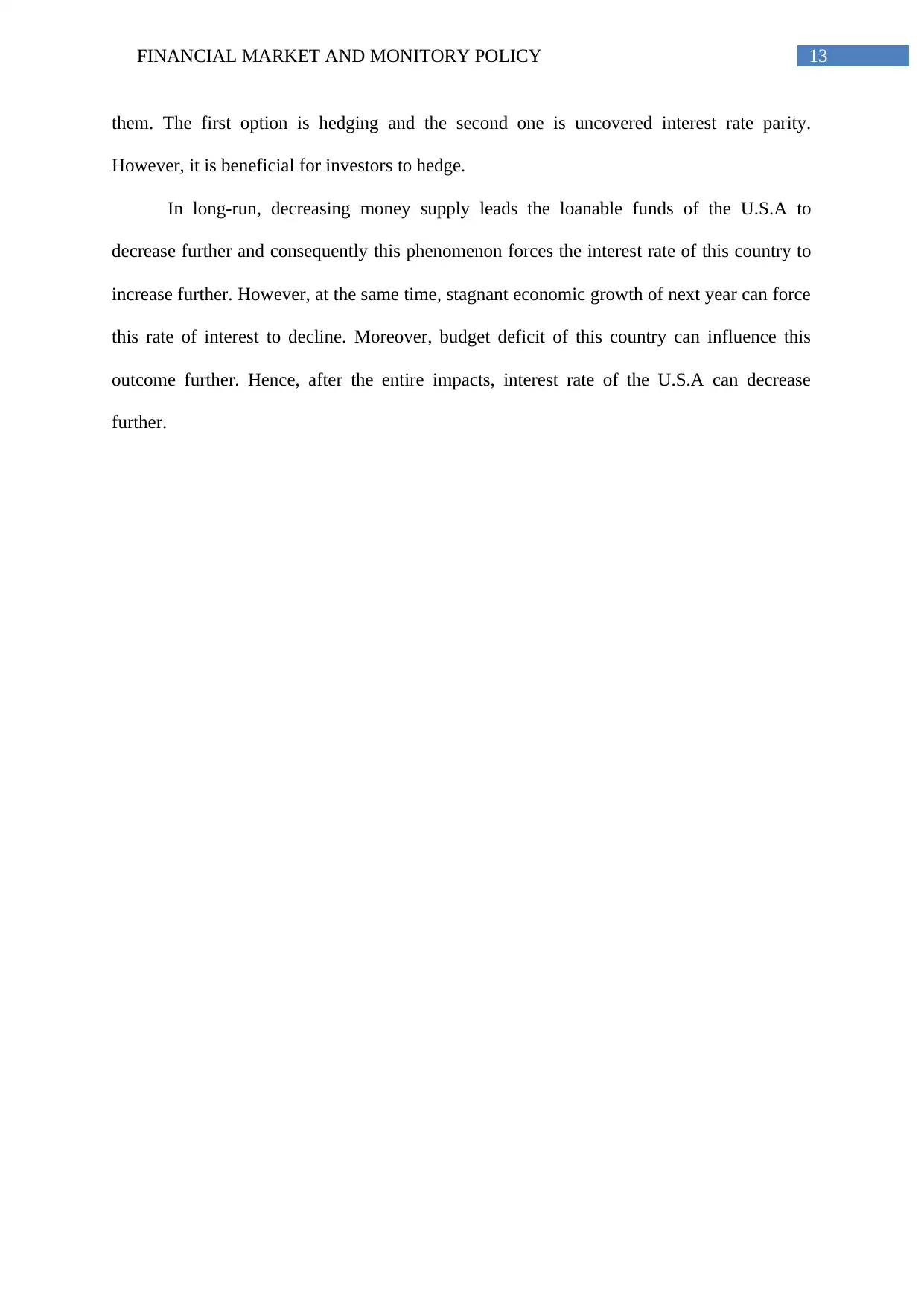
13FINANCIAL MARKET AND MONITORY POLICY
them. The first option is hedging and the second one is uncovered interest rate parity.
However, it is beneficial for investors to hedge.
In long-run, decreasing money supply leads the loanable funds of the U.S.A to
decrease further and consequently this phenomenon forces the interest rate of this country to
increase further. However, at the same time, stagnant economic growth of next year can force
this rate of interest to decline. Moreover, budget deficit of this country can influence this
outcome further. Hence, after the entire impacts, interest rate of the U.S.A can decrease
further.
them. The first option is hedging and the second one is uncovered interest rate parity.
However, it is beneficial for investors to hedge.
In long-run, decreasing money supply leads the loanable funds of the U.S.A to
decrease further and consequently this phenomenon forces the interest rate of this country to
increase further. However, at the same time, stagnant economic growth of next year can force
this rate of interest to decline. Moreover, budget deficit of this country can influence this
outcome further. Hence, after the entire impacts, interest rate of the U.S.A can decrease
further.
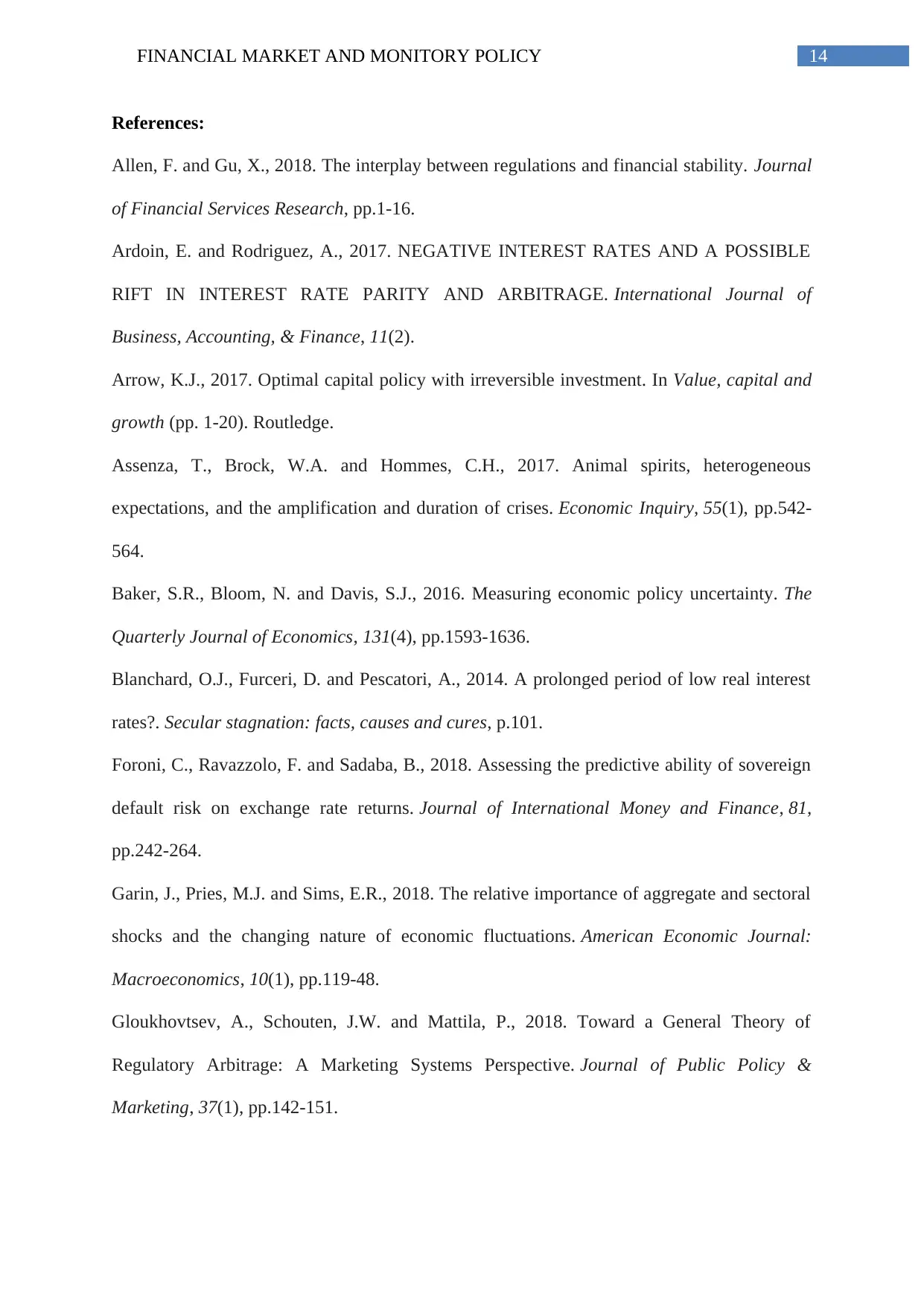
14FINANCIAL MARKET AND MONITORY POLICY
References:
Allen, F. and Gu, X., 2018. The interplay between regulations and financial stability. Journal
of Financial Services Research, pp.1-16.
Ardoin, E. and Rodriguez, A., 2017. NEGATIVE INTEREST RATES AND A POSSIBLE
RIFT IN INTEREST RATE PARITY AND ARBITRAGE. International Journal of
Business, Accounting, & Finance, 11(2).
Arrow, K.J., 2017. Optimal capital policy with irreversible investment. In Value, capital and
growth (pp. 1-20). Routledge.
Assenza, T., Brock, W.A. and Hommes, C.H., 2017. Animal spirits, heterogeneous
expectations, and the amplification and duration of crises. Economic Inquiry, 55(1), pp.542-
564.
Baker, S.R., Bloom, N. and Davis, S.J., 2016. Measuring economic policy uncertainty. The
Quarterly Journal of Economics, 131(4), pp.1593-1636.
Blanchard, O.J., Furceri, D. and Pescatori, A., 2014. A prolonged period of low real interest
rates?. Secular stagnation: facts, causes and cures, p.101.
Foroni, C., Ravazzolo, F. and Sadaba, B., 2018. Assessing the predictive ability of sovereign
default risk on exchange rate returns. Journal of International Money and Finance, 81,
pp.242-264.
Garin, J., Pries, M.J. and Sims, E.R., 2018. The relative importance of aggregate and sectoral
shocks and the changing nature of economic fluctuations. American Economic Journal:
Macroeconomics, 10(1), pp.119-48.
Gloukhovtsev, A., Schouten, J.W. and Mattila, P., 2018. Toward a General Theory of
Regulatory Arbitrage: A Marketing Systems Perspective. Journal of Public Policy &
Marketing, 37(1), pp.142-151.
References:
Allen, F. and Gu, X., 2018. The interplay between regulations and financial stability. Journal
of Financial Services Research, pp.1-16.
Ardoin, E. and Rodriguez, A., 2017. NEGATIVE INTEREST RATES AND A POSSIBLE
RIFT IN INTEREST RATE PARITY AND ARBITRAGE. International Journal of
Business, Accounting, & Finance, 11(2).
Arrow, K.J., 2017. Optimal capital policy with irreversible investment. In Value, capital and
growth (pp. 1-20). Routledge.
Assenza, T., Brock, W.A. and Hommes, C.H., 2017. Animal spirits, heterogeneous
expectations, and the amplification and duration of crises. Economic Inquiry, 55(1), pp.542-
564.
Baker, S.R., Bloom, N. and Davis, S.J., 2016. Measuring economic policy uncertainty. The
Quarterly Journal of Economics, 131(4), pp.1593-1636.
Blanchard, O.J., Furceri, D. and Pescatori, A., 2014. A prolonged period of low real interest
rates?. Secular stagnation: facts, causes and cures, p.101.
Foroni, C., Ravazzolo, F. and Sadaba, B., 2018. Assessing the predictive ability of sovereign
default risk on exchange rate returns. Journal of International Money and Finance, 81,
pp.242-264.
Garin, J., Pries, M.J. and Sims, E.R., 2018. The relative importance of aggregate and sectoral
shocks and the changing nature of economic fluctuations. American Economic Journal:
Macroeconomics, 10(1), pp.119-48.
Gloukhovtsev, A., Schouten, J.W. and Mattila, P., 2018. Toward a General Theory of
Regulatory Arbitrage: A Marketing Systems Perspective. Journal of Public Policy &
Marketing, 37(1), pp.142-151.
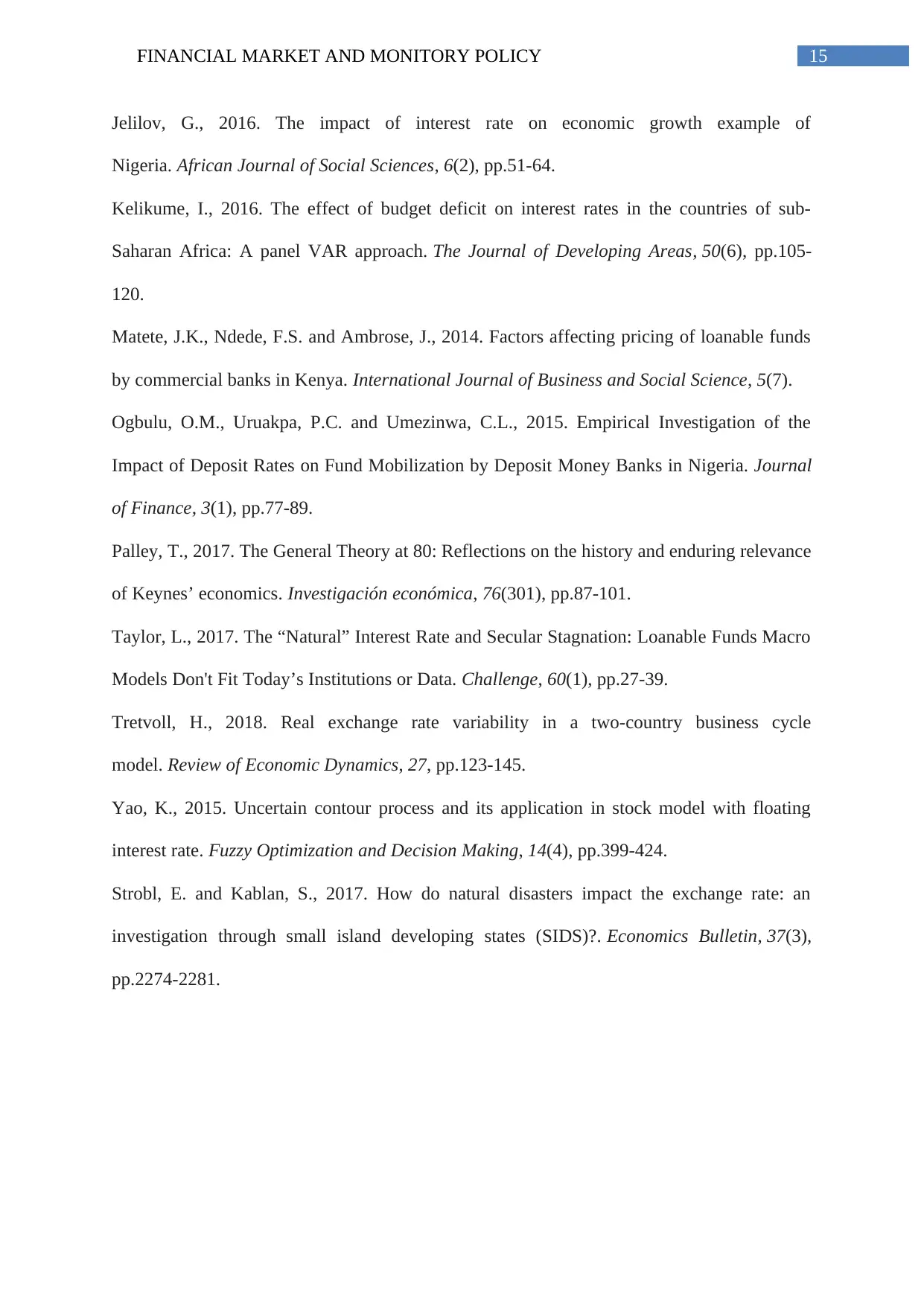
15FINANCIAL MARKET AND MONITORY POLICY
Jelilov, G., 2016. The impact of interest rate on economic growth example of
Nigeria. African Journal of Social Sciences, 6(2), pp.51-64.
Kelikume, I., 2016. The effect of budget deficit on interest rates in the countries of sub-
Saharan Africa: A panel VAR approach. The Journal of Developing Areas, 50(6), pp.105-
120.
Matete, J.K., Ndede, F.S. and Ambrose, J., 2014. Factors affecting pricing of loanable funds
by commercial banks in Kenya. International Journal of Business and Social Science, 5(7).
Ogbulu, O.M., Uruakpa, P.C. and Umezinwa, C.L., 2015. Empirical Investigation of the
Impact of Deposit Rates on Fund Mobilization by Deposit Money Banks in Nigeria. Journal
of Finance, 3(1), pp.77-89.
Palley, T., 2017. The General Theory at 80: Reflections on the history and enduring relevance
of Keynes’ economics. Investigación económica, 76(301), pp.87-101.
Taylor, L., 2017. The “Natural” Interest Rate and Secular Stagnation: Loanable Funds Macro
Models Don't Fit Today’s Institutions or Data. Challenge, 60(1), pp.27-39.
Tretvoll, H., 2018. Real exchange rate variability in a two-country business cycle
model. Review of Economic Dynamics, 27, pp.123-145.
Yao, K., 2015. Uncertain contour process and its application in stock model with floating
interest rate. Fuzzy Optimization and Decision Making, 14(4), pp.399-424.
Strobl, E. and Kablan, S., 2017. How do natural disasters impact the exchange rate: an
investigation through small island developing states (SIDS)?. Economics Bulletin, 37(3),
pp.2274-2281.
Jelilov, G., 2016. The impact of interest rate on economic growth example of
Nigeria. African Journal of Social Sciences, 6(2), pp.51-64.
Kelikume, I., 2016. The effect of budget deficit on interest rates in the countries of sub-
Saharan Africa: A panel VAR approach. The Journal of Developing Areas, 50(6), pp.105-
120.
Matete, J.K., Ndede, F.S. and Ambrose, J., 2014. Factors affecting pricing of loanable funds
by commercial banks in Kenya. International Journal of Business and Social Science, 5(7).
Ogbulu, O.M., Uruakpa, P.C. and Umezinwa, C.L., 2015. Empirical Investigation of the
Impact of Deposit Rates on Fund Mobilization by Deposit Money Banks in Nigeria. Journal
of Finance, 3(1), pp.77-89.
Palley, T., 2017. The General Theory at 80: Reflections on the history and enduring relevance
of Keynes’ economics. Investigación económica, 76(301), pp.87-101.
Taylor, L., 2017. The “Natural” Interest Rate and Secular Stagnation: Loanable Funds Macro
Models Don't Fit Today’s Institutions or Data. Challenge, 60(1), pp.27-39.
Tretvoll, H., 2018. Real exchange rate variability in a two-country business cycle
model. Review of Economic Dynamics, 27, pp.123-145.
Yao, K., 2015. Uncertain contour process and its application in stock model with floating
interest rate. Fuzzy Optimization and Decision Making, 14(4), pp.399-424.
Strobl, E. and Kablan, S., 2017. How do natural disasters impact the exchange rate: an
investigation through small island developing states (SIDS)?. Economics Bulletin, 37(3),
pp.2274-2281.
1 out of 16
Your All-in-One AI-Powered Toolkit for Academic Success.
+13062052269
info@desklib.com
Available 24*7 on WhatsApp / Email
![[object Object]](/_next/static/media/star-bottom.7253800d.svg)
Unlock your academic potential
© 2024 | Zucol Services PVT LTD | All rights reserved.



